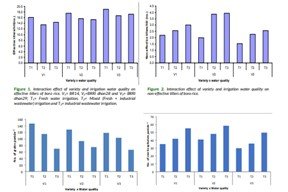Effect of source of irrigation water on yield performance of Boro rice
Abstract
Industrial wastewater is a major problem in Gazipur, Bangladesh which is very cheaply available in the surrounding area for crop production. An experiment was conducted at Farmer’s Field of Gazipur district to study the effect of irrigation water quality on yield of boro rice. The study comprised three varieties viz., BR14, BRRI dhan28 and BRRI dhan29 and three sources of irrigation water viz. fresh water irrigation, mixed water (fresh + industrial wastewater) irrigation, industrial wastewater irrigation. The experiment was laid out in a split-plot design with three replications where irrigation water was assigned in the main plot and rice varieties in the subplot. BRRI dhan29 produced the tallest plant (85.25 cm), the highest number of total tillers hill-1 (19.77), effective tillers hill-1 (17.64), grains panicle-1 (111.0), sterile spikelets panicle-1 (44.29), 1000-grain weight (22.43 g), grain yield (4.56 t ha-1) and straw yield (7.99 t ha-1). On the other hand, plant height (74.50 cm), total tillers hill-1 (19.82), effective tillers hill-1 (17.53), grains panicle-1 (131.7), sterile spikelets panicle-1 (35.50), 1000-grain weight (25.83 g), grain yield (5.05 t ha-1) were found highest when applied fresh water irrigation. The highest numbers of grains panicle-1 (119.14), 1000-grain weight (25.10 g), grain (5.54 t ha-1) and straw (7.93 t ha-1) yield were obtained in BRRI dhan29 with fresh water irrigation. Therefore, BRRI dhan29 with fresh water irrigation would be safe to use. However, if fresh water irrigation is not possible, conjunctive use of fresh and wastewater can be used as irrigation for BRRI dhan29.
Keywords:
Boro rice, Fresh water, Irrigation, Industrial wastewater, Water qualityDownloads
References
Afrad, M.S.I., Monir, M.B., Haque, M.E., Barau, A.K. and Haque, M.M. (2020). Impact of industrial effluent on water, soil and Rice production in Bangladesh: a case of Turag River Bank. Journal of Environmental Health Science and Engineering, https://doi.org/10.1007/s40201-020-00506-8
Ahaduzzaman, S.P., Anjum, A. and Khan, E.A. (2017). Overview of major industries in Bangladesh. Journal of Chemical Engineering, 30:51-58.
Anjuman, S. (2012). Effect of cultivar and source of phosphorous on the performance of transplant aman rice. M.S. Thesis, Department of Agronomy, Bangladesh Agricultural University, Mymensingh. pp. 31.
Aryal, J.P., Mehrotra, M.B., Jat, M.L. and Sidhu, H.S. (2015). Impacts of laser land leveling in rice–wheat systems of the north–western indo-gangetic plains of India. Food Security, 7:725-738.
BBS, Bangladesh Bureau of Statistics (2018). Monthly Statistical Bulletin, Ministry of Planning. Government of the People’s Republic of Bangladesh. Dhaka. pp. 49-69.
Begum, R.A., Zaman, M.W., Mondol, A.T.M.A.I., Islam, M.S. and Hossain, K.M.F. (2011). Effects of textile industrial waste water and uptake of nutrients on the yield of rice. Bangladesh Journal of Agricultural Research, 36: 319-331.
Brammer, H. (1971). Agricultural development possibilities in Bangladesh. Soil survey project technological report. No. 42. United Nations Development Program, FAO, Rome.
BRRI, Bangladesh Rice Research Institute (2010). Fertilizer requirement for Boro rice production in 2009-10. Bangladesh Rice Research Institute, Joydebpur. p. 10.
Chowdhury, S.A., Paul, S.K. and Sarkar, M.A.R. (2016). Yield performance of fine aromatic rice in response to variety and level of nitrogen. Journal of Environmental Science & Natural Resources, 9:41-44.
Gomez, K.A. and Gomez, A.A. (1984). Statistical procedure for agricultural research. International Rice Research Institute. John Wiley and Sons. New York. pp. 1-34.
Islam, M.S., Sarkar, M.A.R. and Salam, M.A. (2013). Screening of different aromatic and non-aromatic fine rice varieties in Aman season in terms of yield. Bangladesh Journal of Nuclear Agriculture, 29:59-66.
Jisan, M.T., Paul, S.K. and Salim, M. (2014). Yield performance of some transplant Aman rice varieties as influenced by different levels of nitrogen. Journal of Bangladesh Agricultural University, 12: 321-24.
Khai, H.V. and Yabe, M. (2012). Rice yield loss due to industrial water pollution in Vietnam. Journal of US-China Public Administration, 9: 248-56.
Kirttania, B. (2013). Effect of variety, age of tiller seedling and Nitrogen management on the growth and yield of transplant aman rice. M.S. Thesis, Department of Agronomy, Bangladesh Agricultural University, Mymensingh. pp. 26-73.
Kumar, V., Chopra, A.K., Srivastava, S., Singh, J. Thakur, R.K. (2017). Irrigating okra with secondary treated municipal wastewater: Observations regarding plant growth and soil characteristics. International Journal of Phytoremediation, 19(5): 490-499.
Rikabder, M.F.H. (2004). Dhan Chaser nana katha (In Bengaki). Krishikatha, 64: 39-40.
Sangeetha, S.P., Balakrishnan, A. and Devasenapathy, P. (2013). Influence of organic manures on yield and quality of rice (Oryza sativa L.) and blackgram (Vigna mungo L.) in rice-blackgram cropping sequence. American Journal of Plant Sciences, 4:7.
Sarkar, S.K., Sarkar, M.A.R., Islam, N. and Paul, S.K. (2014). Yield and quality of aromatic fine rice as affected by variety and nutrient management. Journal of Bangladesh Agricultural University, 12:279-284.
Statista (2020). Global rice consumption 2019/20, by country. Retrieved August, 12 2020 from www.statista.com/statistics/255971/top-countries-based-on-rice-consumption-2012-2013/
Tyeb, A., Paul, S.K. and Samad, M.A. (2013). Performance of variety and spacing on the yield and yield contributing characters of transplanted Aman rice. Journal of Agroforestry and Environment, 7: 57-60.

Published
How to Cite
Issue
Section
Copyright (c) 2020 Agriculture and Environmental Science Academy

This work is licensed under a Creative Commons Attribution-NonCommercial 4.0 International License.




